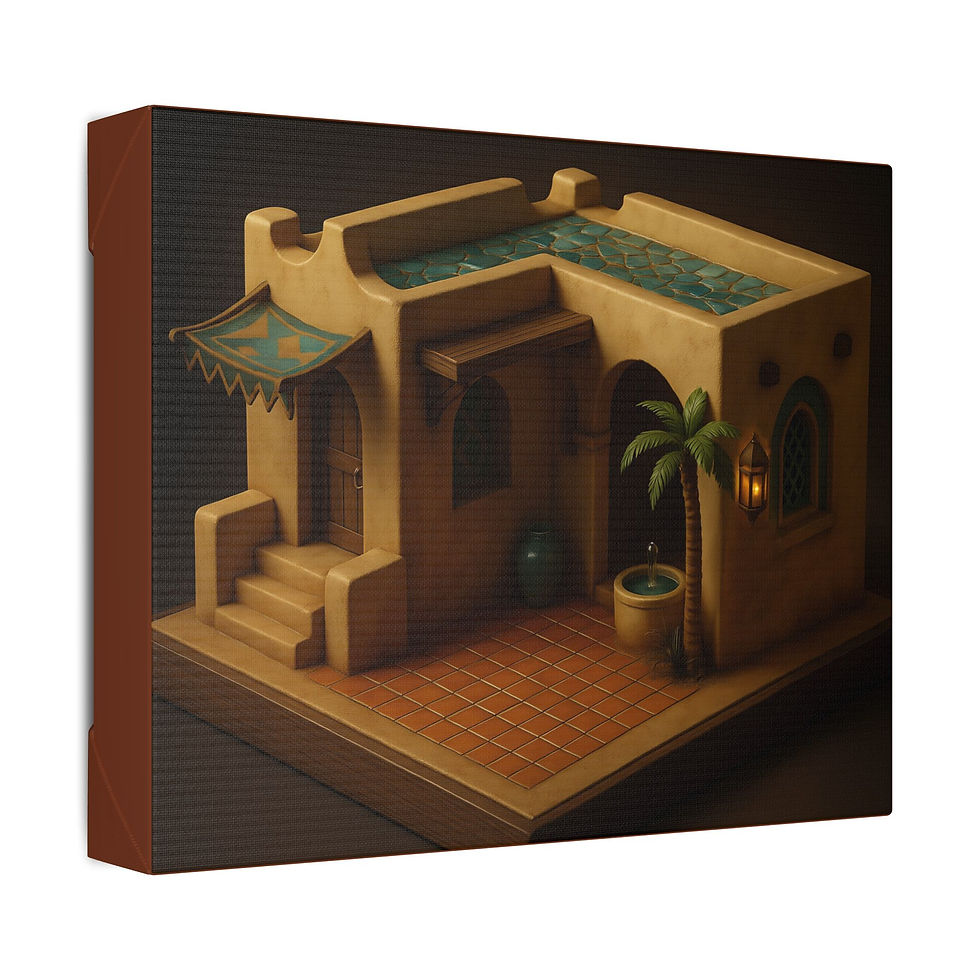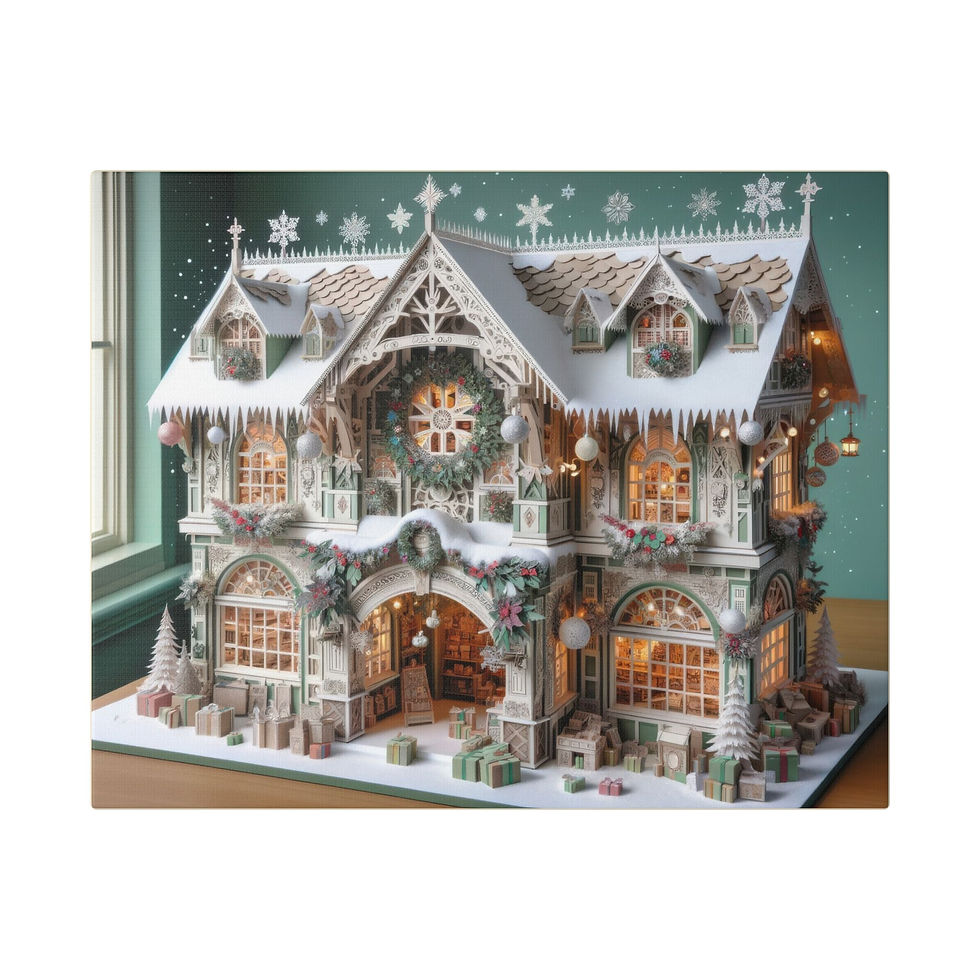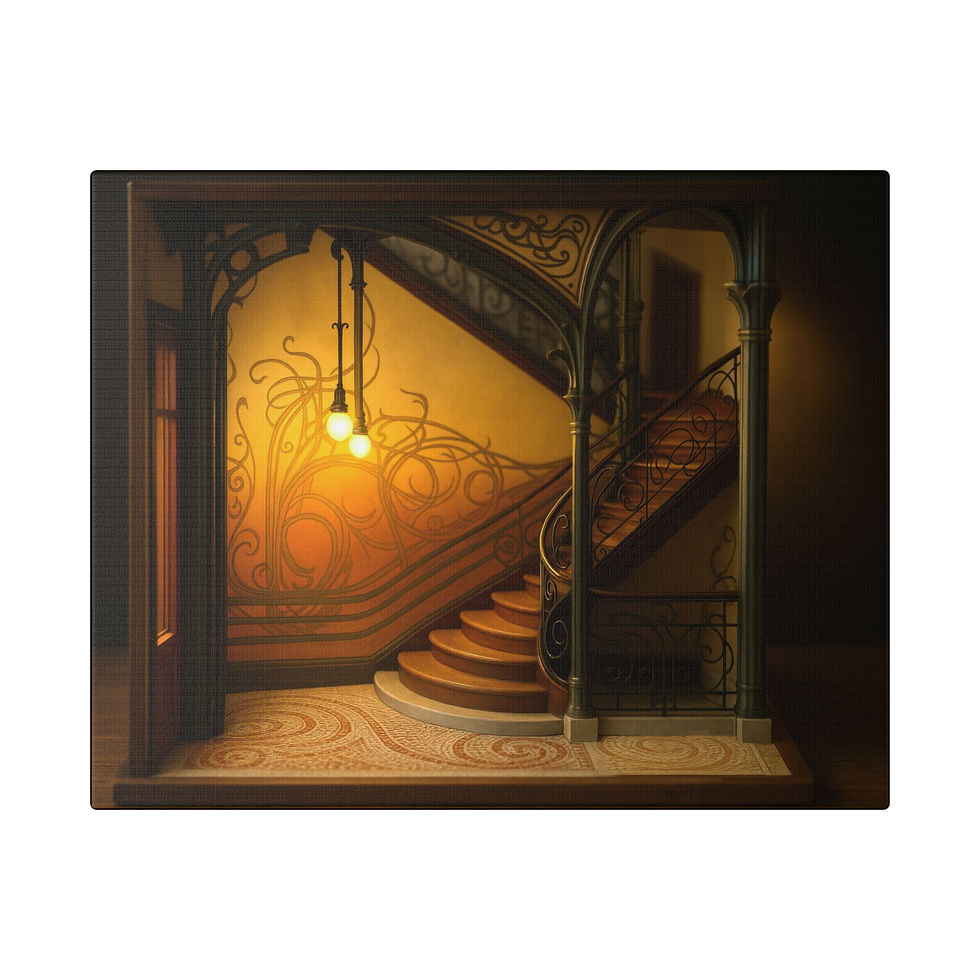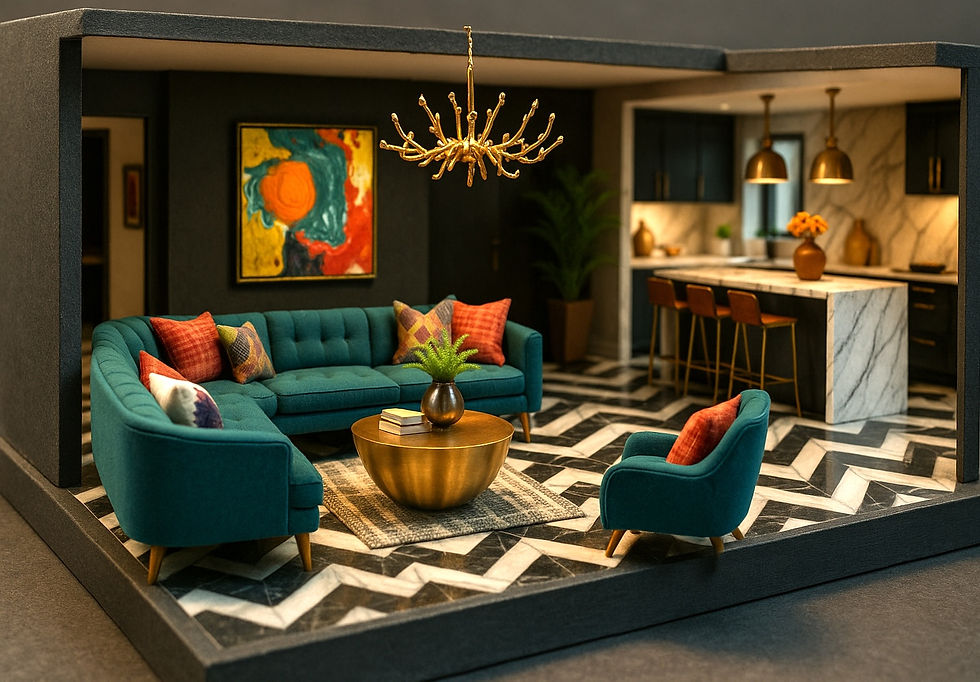The Clockwork Canteen: A Steampunk Miniature Food Truck with Big Flavor in a Tiny World
- Brandon

- 2 days ago
- 9 min read
Opening – First Impressions in Miniature
There are days when a miniature saunters into my mind and politely asks to clear my schedule. This is one of those days. Meet The Clockwork Canteen, a fantasy steampunk food truck that looks like it drove off a Jules Verne dust jacket, got bedazzled by a clockmaker, and decided to sell snacks. Brass piping? Check. Copper filigree? Everywhere. Wheels the size of great ideas? Two of them, audacious and proud. And the glow! That warm workshop light spilling from the service window has the exact color temperature of “I’ll take one more pastry even though I promised I wouldn’t.”
I love this piece because it does two things at once: it’s a beautifully composed food truck all by itself, and it’s a storytelling machine that turns every valve and rivet into a plot point. Stick with me—later in the post I’ll walk you through a build approach (bones to glaze) so you can craft your own gear-slinging snack wagon. But first, a little VIP talk.
Why This Photo Needs VIP Treatment
You’re looking at a web-optimized image—perfect for scrolling, not quite sharp enough for that glorious spot above your coffee station or hobby bench. I’m prepping a high-resolution canvas print of this scene (FREE U.S. shipping) because the copper patina and micro-machined details reward every inch. I’ll drop the product link and a beauty shot of the canvas right here soon, so you can bring the warm workshop glow home. Consider it your daily dose of tiny caffeine. https://www.smallworldminiatures.com/product-page/the-clockwork-canteen-miniature-canvas-print
Miniature Backstory – The Tiny Tale
Every truck has a route; this one has a legend.
Name: The Clockwork Canteen Founded: 1889½ (the paperwork jammed in the pneumatic tube mid-year) Proprietor: Chef Aurelia Thimblewright, former apprentice to a royal aeronautical boilermaker who discovered that perfectly steamed milk requires precisely the same pressure profile as a well-behaved dirigible.Signature Menu: Aether-Lattes, Coal-Fired Crème Puffs, and the Sprocket Samosa—folded with a six-tooth crimp for safety.Quirky
Locals:
Piston, a bronze cat with a moon-shaped collar, naps on warm manifolds and inspects every pastry for… structural integrity.
Captain Blintz, retired airship navigator, orders “just a coffee” but leaves with a satchel of éclairs and life advice.
The Arborists, a guild dedicated to trimming trees into perfect cloud shapes, keep the truck’s route clear and the gossip hot.

Aurelia’s truck runs on a secret blend of clock-spring tension and the last polite puff of steam from each brew. If you look closely, there’s a tiny teaspoon welded near the front grill—a gift from the Arborists after Aurelia rescued a runaway teapot on a windy Tuesday. Easter egg hunters, you’ve been notified.
A Guided Tour of the Build
Step closer. The truck’s skin is a gently weathered ivory enamel, smudged with honest work and edged in warm copper. Rivets march along the panels like tiny brass drumlines. The cab’s window frames echo Art Nouveau curves—more jewelry than hardware—while the service awning lifts to reveal a compact galley trimmed with knurled dials, toggle switches, and a pastry case that glows like treasure in a dragon’s hoard.

Under the counter, a forest of gears meshed like a watchmaker’s daydream churns quietly. Two oversized rear wheels—spoked, scalloped, impossible to ignore—give the silhouette that whimsical “cart-meets-carousel” posture. Copper stacks and pressure domes parade across the roofline, and yes, the steam plumes do the joyful three-puff rhythm that means the milk is ready.

Around the truck, manicured cloud trees and pebble paths turn the scene into a traveling parklet, dotted with brass streetlamps and little experiments that might also be percolators. The light is intentionally golden, syncing with the pastry display so the whole truck reads like late afternoon—prime snack o’clock.
Inspirations – From the Big World to the Small
The Clockwork Canteen’s DNA comes from three branches of the architectural family tree:
Victorian Industrial & Brunel School: Think iron bridges, riveted plates, and steam-age optimism. Those roof stacks and pressure tanks echo the confidence of Victorian engineering—form built from function but in love with ornament.
Art Nouveau: Hector Guimard & Victor Horta: Curves that grow like vines, windows that feel leaf-veined, and ornament that looks alive. The truck’s window grilles and lamp standards share that botanical elegance, scaled down without losing the sway.
Coachwork & Early Delivery Vans: From vintage step vans to 1930s coachbuilt motors, the boxy-yet-friendly silhouette gives us a stage to decorate. In miniature, the proportions exaggerate the story: larger wheels, chunkier trim, overscaled rivets that photograph beautifully and read clearly from a distance.

Miniature design trick: grab the gesture of each influence (the curve of a window, the spacing of rivets, the tilt of a stack) rather than replicating any single building or vehicle. That’s how you get something that feels authentic without copying a specific reference—the magic sweet spot of worldbuilding.
Artist Tips – Make Your Own Magic
Ready to build your own steam-slinging snack machine? You’ve got this. We’ll go from bones to glaze, with safety notes, scale sanity checks, and enough greebles to make a watchmaker blush.
A. Shopping List (raid-the-house edition first)
Around the House (clever reuses):
Bottle caps & pen parts: wheels, pressure valves, funnels, conduit rings
Old USB cables & phone charger wires: flexible piping and cable looms
Tea strainers & sink aerators: vents and domed filters
Soda can aluminum: thin “metal” sheet for paneling and decorative straps
Coffee stirrers & popsicle sticks: floorboards, trim, awning ribs
Beads, eyelets, and nail art studs: rivets, knobs, and gauge bezels
Mesh from produce bags: radiator grilles and safety screens
Paper clips & bread ties: brackets, hinges, handrails
Clear blister packaging: windows and pastry case glazing
Cotton balls: steam plumes (tinted with a tea wash)

Purchasable equivalents (if the junk drawer is empty):
Styrene sheets/strip (Evergreen/Plastruct) for clean paneling and frames
Brass rod/tube & copper wire for pipes, ladders, and railings
Watch repair assortments (inexpensive mixed gears) for the undercarriage
Laser-cut wood for crisp doors and signboards
Acrylic paints (matte), metallics (copper, brass, gunmetal), and oil paints for weathering
Pigments (soot, rust, dust), CA glue, PVA/wood glue, epoxy
Warm-white micro LED kit or USB fairy lights
Matte & satin varnish, black primer, etching primer for metal bits
Tools: hobby knife, razor saw, sprue cutters, pin vise and micro bits, files, tweezers, clamps, small square/ruler

Safety Essentials: nitrile gloves, eye protection, ventilation for sprays and CA glue, a cutting mat, and clamps so your fingers don’t volunteer as temporary clamps.
B. Deep Dive (numbered steps)
0) Scout a donor truck (quick win).
Hit a thrift store, toy aisle, or hobby swap for a die-cast step van/bread truck around 1:24-ish scale. Favor boxy sides, a flat-ish roof, and simple wheel wells—easy to re-skin and stack with pipes. Make sure the shell opens or can be hollowed; decals can be lifted with isopropyl and a gentle scrub.

Plan the scale and pose: Decide how “chunky” you want details to read in photos. A good rule: a door should be roughly twice the width of your thumb at the chosen scale—call it 1:24–1:20 vibes for trucks like this. Sketch the side profile with exaggerated rear wheels and a service window. Choose your hero view (three-quarter front is classic) and plan lighting so your pastry case glows from that angle.

Bones: frame and box: Build a rectangular truck body from foamcore or styrene sheet, keeping edges square. Reinforce inside corners with triangle gussets. The cab can be a shallow wedge glued front-left to break the boxiness. Sandwich thin soda-can strips over the edges to simulate metal seams; add bead “rivets” in rhythmic rows. Make wheel wells now so you don’t fight them later.

Chassis & wheels with personality: Cut two oversized rear wheels from layered chipboard or 3D-printed discs if you have them. Overlay watch gears or laser-cut spokes; cap with a bead hub. Front wheels a touch smaller, with fenders cut from curved shampoo-bottle plastic (it takes paint beautifully after scuffing). Pin wheels to the body with brass rod axles; shim until the stance is slightly forward-leaning—makes it look ready to roll.

Windows & doors: Frames: styrene strip or coffee-stirrer wood, softened with sanded curves. Inset clear blister plastic for glazing. For the service hatch, hinge a panel along the top using fabric tape hidden under a copper “hinge” strip. Add a peephole or oval window with nail art studs as faux screws.

Pipes, stacks, and the rooftop parade: This is your skyline. Mix brass tube, old pen barrels, and beads to create boilers, condensers, and whimsical domes. Keep diameters varied (small → medium → cone) so the eye travels. Anchor each element with pins through the roof into interior blocks of wood—safer than relying on glue alone.

Galley & counter: Build a shallow counter with a thin acrylic pastry case. Shelves hold jars (beads), tins (mini bottle caps), and gauges (watch faces or printed circles under clear resin drops). Add a miniature milk frother: a cut-down pen spring on a wire handle. Keep silhouettes bold; tiny detail reads best when it rests on simple shapes.

Utilities & greebles: Under the serving hatch, go wild with gears, springs, and tubing. Think “logic” without realism: a big gear turns three small gears that tug a chain that absolutely doesn’t do anything but looks essential. Bundle wires with bits of heat-shrink or tape for tidy looms.

Base & environment: Seat the truck on a sandy lane with glued-down pebbles and tufts (paintbrush bristles + PVA). Add two or three cloud trees: wire armatures coated with spackle, topped with foam foliage trimmed into marshmallow shapes. Brass streetlamps from beads and rod make the world feel inhabited.

Color choreography: Prime black for metal depth, grey for wood/plastic. Spray or brush a warm ivory on body panels. Mix copper: 2 parts copper metallic + a whisper of orange to keep it lively. Shade with a thin burnt umber wash. Bring out edges with a controlled dry-brush of pale ivory. For patina, stipple a hint of turquoise around rivets and beneath joints, then mute with a brown glaze so it whispers rather than shouts.
Weathering stack:
Pin wash: oil paint (raw umber) thinned with odorless mineral spirits into panel lines.
Soot: black pigment brushed around stacks and vents, fixed with isopropyl alcohol mist.
Grease: graphite rubbed along moving bits; a touch of gloss varnish in drips.
Rust blooms (sparingly on copper/brass): red-brown pigment speckled, sealed, then knocked back with a dark glaze.

Lighting (simple & safe): Tuck a USB-powered warm-white LED strand inside the truck. Diffuse with parchment or vellum so bulbs don’t hotspot. Route the wire through the base to a hidden USB jack—power from a phone charger, no soldering necessary. If you use coin cells, keep them in a snap case and mark the on/off tab clearly (future-you will thank you).
Furniture & soft goods: Bar towels from facial tissue, sealed with dilute PVA. A chalkboard menu from black card with white gel pen text. Add a stool: bead seat on a wire post, mounted into a pebble “foot.”

Story clutter & Easter eggs: Scatter a tiny tool tray, a stray gear near the tire, and a spoon tucked at the front grill (you remembered!). A bronze cat—even a bead with ears—near a warm pipe creates instant character. Consider a mini ledger with an Arborists’ stamp.

Photo tips & backdrop ideas: Shoot at eye level with the truck; miniatures look most real from a scale person’s height. Use a deep green or charcoal gradient backdrop to echo the garden setting. One key light (softbox or desk lamp through parchment) from the front-left, one rim light from behind to kiss the stacks, and let the internal LEDs do their cozy magic. Sprinkle a few out-of-focus pebbles near the lens for depth. Cotton or wool teased thin works for gentle steam in still shots; anchor it on a wire so you can pose the plumes.

Troubleshooting (quick fixes)
Problem: LEDs look harsh and clinical.Fix: Add parchment or thin white foam as a diffuser; switch to warm LEDs; glaze the window interior with a thin amber wash.
Problem: Paint reads flat and toy-like.Fix: Add a pin wash in panel lines, then dry-brush edges with a lighter body color. Finish with a light dust glaze to unify.
Problem: Superglue fogged the windows.Fix: Replace the pane (sorry!) and use PVA or canopy glue for clear parts. For minor fogging, polish with plastic headlight compound.
Problem: Scale drift—door knob is giant, rivets are tiny.Fix: Pick a human reference (a 1:24 figure or a coin) and compare every add-on before gluing. Better to overscale a little than underscale; big details read better in photos.
Problem: Gears keep popping off.Fix: Pin large pieces with a short length of wire into a drilled hole; backfill with epoxy for shock resistance.
Problem: Truck sits crooked on the base.Fix: Shim with paperboard under the low wheel, cover with a tuft or pebble, and call it “terrain-aware suspension.”
Closing – Until Next Time in the Small World
If you spot Piston the cat, the Arborists’ teaspoon, or Captain Blintz’s suspicious second éclair, you’re officially part of the Clockwork Canteen’s regulars. I had a ridiculous amount of fun touring this hero truck with you. Tell me in the comments: what’s your favorite detail—the rooftop domes, the pastry glow, or those audacious wheels? And if you’re building your own steam-powered snack-mobile, tag it #smallworldminiatures so I can cheer you on (and probably order a miniature latte).
Want more builds, tips, and behind-the-scenes mishaps? Join the newsletter—it’s where I send new tutorials, printable guides, and first dibs on prints.
Hashtags
#miniature #miniatures #diorama #steampunk #steampunkart #miniatureart #modelmaking #modelbuilder #kitbashing #scratchbuild #scale_model #tinyworld #miniaturephotography #dollhouseminiatures #artnouveau #fantasyart #tabletopterrain #wargamingterrain #hobbycraft #modelrailway #weathering #ledlighting #crafting #makersgonnamake #creativehobby #miniaturecommunity #brassandcopper #foodtruck #smallworldminiatures







































Comments